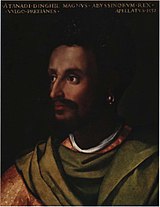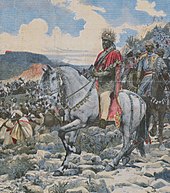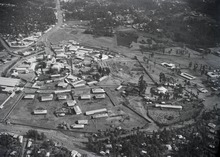Ethiopian Empire
Ethiopian Empire መንግሥተ ኢትዮጵያ ( Amharic) Yäʾityop̣p̣ya Nägusä Nägäst Mängəśt | |||||||||
|---|---|---|---|---|---|---|---|---|---|
| 1270–1974 1936–1941: Government-in-exile | |||||||||
| Motto: ኢትዮጵያ ታበፅዕ እደዊሃ ኀበ እግዚአብሔር Ityopia tabetsih edewiha ḫabe Igziabiher (English: " State religions: | |||||||||
| Demonym(s) | Endonym: Ethiopian Exonym: Abyssinian | ||||||||
| Government | parliamentary constitutional monarchy (1931–1974) | ||||||||
| Emperor | |||||||||
• 1270–1285 (first) | Yekuno Amlak[6] | ||||||||
• 1930–1974 (last) | Haile Selassie | ||||||||
Habte Giyorgis | |||||||||
• 1974 (last) | Mikael Imru | ||||||||
| Legislature | None ( Menelik's Expansions | 1878–1904 | |||||||
| 1895–1896 | |||||||||
| 16 July 1931 | |||||||||
• Second Italo-Ethiopian War (annexed into Italian East Africa) | 3 October 1935 | ||||||||
| 5 May 1941 | |||||||||
| 11 September 1952 | |||||||||
• Coup d'état by the Derg | 12 September 1974 | ||||||||
| 21 March 1975[8][9][10][11] | |||||||||
| Area | |||||||||
| 1954 | 1,221,900 km2 (471,800 sq mi) | ||||||||
| Currency |
| ||||||||
| |||||||||
The Ethiopian Empire,
Founded in 1270 by
The neighboring Muslim
Emperor
Later, after the
History
Background
After the fall of the
The Zagwe were not able to stop squabbling over the throne, diverting men, energy and resources that could have been used to affirm the dynasty's authority. By the late 13th century, a young
Early Solomonic Period

Yekuno Amlak would rise to the throne by 1270 AD. He was allegedly a descendant of the last king of Aksum, Dil Na'od, and hence the royal kings of Aksum. Through the Aksumite royal lineage, it was also claimed that Yekuno Amlak was a descendant of the biblical king Solomon. The canonical form of the claim was set out in legends recorded in the Kebra Nagast, a 14th century text. According to this, the Queen of Sheba, who supposedly came from Aksum, visited Jerusalem where she conceived a son with King Solomon. On her return to her homeland of Ethiopia, she gave birth to the child, Menelik I. He and his descendants (which included the Aksumite royal house) ruled Ethiopia until overthrown by the Zagwe usurpers. Yekuno Amlak, as a supposed direct descendant of Menelik I, was therefore claimed to have "restored" the Solomonic line.[32]
Throughout Yekuno Amlak reign he would enjoy friendly relations with the Muslims. He not only had established close ties with the neighboring Makhzumi dynasty but had also made contact with the Rasulids in Yemen and the Egyptian Mamluk Sultanate. In a letter sent to the Mamluke Sultan Baybars, he would state his intention of friendly cooperation with the Muslims of Arabia, and described himself as being a protector of all Muslims in Abyssinia. A devout Christian, he would order the construction of the church of Genneta Maryam, commemorating his work with an inscription that reads, "By the grace of God, I king Yekuno Amlak, after I had come to the throne by the will of God, built this church."[32][33]
In 1285 Yekuno Amlak was succeeded by his son
Amda Seyon's Conquests

The warlike emperor of Amda Seyon I conducted many campaigns in Gojjam, Damot and Eritrea, but his most important campaigns were against his Muslim enemies to the east, which shifted the balance of power in favour of the Christians for the next two centuries. Around 1320, Sultan an-Nasir Muhammad of the Mamluk Sultanate based in Cairo began persecuting Copts and destroying their churches. Amda Seyon then threatened to divert the flow of the Nile if the sultan did not stop his persecution. Haqq ad-Din I, sultan of Ifat, seized and imprisoned an Ethiopian envoy on his way back from Cairo. Amda Seyon responded by invading the Sultanate of Ifat, killing the sultan, sacking the capital and ravaging the Muslim territories, taking livestock, killing many inhabitants, destroying towns and mosques, and taking slaves.[36]
The Ifat sultan was succeeded by Sabr ad-Din I who rallied the Muslims and waged a rebellion against the Ethiopian occupation. Amda Seyon responded by launching another campaign against his Muslim adversaries to the east, killing the Sultan and campaigning as far as Adal, Dawaro and Bali in present day eastern Ethiopia. Amda Seyon's conquests significantly expanded the territory of the Ethiopian Empire, more than doubling it by size and establishing complete hegemony over the region. Relations between the Muslims of the Horn and the Ethiopian Empire seems to have broken down completely around this era, with the chronicler referring to the Muslims in the east and along the coast as "liars, hyenas, dogs, children of evil who deny the son of Christ."[37][38]
Golden age of Solomonic Rule

Following Amda Seyon's campaigns to the east. Most of the Muslims in the Horn would become tributaries to the Ethiopian Empire, among them being the
In 1382,
However, the remaining Walashma returned from their exile in 1415 and established the Adal Sultanate centred around the Harar region. The Muslims then began to harass Christian held territories in the east prompting Emperor Yeshaq I to dedicate much of his time to defending his eastern peripheral territories, he seems to have employed several Egyptian Christian advisors to drill his army and teach them how to make Greek fire. These advances were not enough to keep the Muslims at bay and Emperor Yeshaq was soon killed fighting the Adalites in 1429. Yeshaq's death was followed by several years of dynastic confusion during which 5 emperors succeeded each other in 5 years. However in 1434, Zara Yaqob of Ethiopia would establish himself on the throne.[42]
During his first years on the throne,
Adal Sultanate Invasion

In 1527 a young imam by the name of
The Emperor was succeeded by his 18 year old son,
After the catastrophe at Wofla, the surviving Portuguese were able to meet up with
In 1559 Gelawdewos was killed attempting to invade Adal Sultanate at the Battle of Fatagar, and his severed head was paraded in Adal's capital Harar.[49]
Early modern period
The Ottoman Empire occupied parts of Ethiopia, from 1557, establishing Habesh Eyalet, the province of Abyssinia, by conquering Massawa, the Empire's main port and seizing Suakin from the allied Funj Sultanate in what is now Sudan. In 1573 the Adal Sultanate attempted to invade Ethiopia again however Sarsa Dengel successfully defended the Ethiopian frontier at the Battle of Webi River.[50]
The Ottomans were checked by
In 1636, Emperor
Modern era

From 1769 to 1855, the Ethiopian empire passed through a period known as the Princes Era (in Amharic: Zemene Mesafint). This was a period of Ethiopian history with numerous conflicts between the various
In 1868, following the imprisonment of several
From 1874 to 1876, the Empire expanded into
The 1880s were marked by the Scramble for Africa. Italy, seeking a colonial presence in Africa, was awarded Eritrea by Britain which led to the Italo-Ethiopian War of 1887–1889 and the scramble for Eritrea's coastal regions between King Yohannes IV of Tembien and Italy. After the death of Emperor Yohannes IV, Italy signed a treaty with Shewa (an autonomous kingdom within the empire), creating the protectorate of Abyssinia.
Due to significant differences between the Italian and Amharic translations of the treaty, Italy believed they had subsumed Ethiopia as a protectorate, while Menelik II of Shewa repudiated the protectorate status in 1893. Insulted, Italy declared war on Ethiopia in 1895. The First Italo-Ethiopian War resulted in the 1896 Battle of Adwa, in which Italy was decisively defeated by the numerically superior Ethiopians. As a result, the Treaty of Addis Ababa was signed in October, which strictly delineated the borders of Eritrea and forced Italy to recognize the independence of Ethiopia. Due to the Entoto Reforms, which provided the Ethiopian Military with modern rifles, many Italian Commanders expressed shock when seeing that some Ethiopians had more advanced rifles than the average Italian Infantryman.
Beginning in the 1890s, under the reign of the
Delegations from the United Kingdom and France – European powers whose colonial possessions lay next to Ethiopia – soon arrived in the Ethiopian capital to negotiate their own treaties with this newly-proven power.
Italian invasion and World War II

In 1935 Italian soldiers, commanded by Marshal Emilio De Bono, invaded Ethiopia in what is known as the Second Italo-Ethiopian War. The war lasted seven months before an Italian victory was declared. The Ethiopian Empire was occupied into the Italian colony of Italian East Africa. The invasion was condemned by the League of Nations, though not much was done to end the hostility.
During the conflict, both Ethiopian and Italian troops committed war crimes. Ethiopian troops are known to have made use of
On 10 June 1940, Italy declared war on the United Kingdom and France, as France was in the process of being conquered by
Post War Ethiopia

On 27 August 1942,
Despite his centralization policies that had been made before World War II, Haile Selassie still found himself unable to push for all the programs he wanted. In 1942, he attempted to institute a progressive tax scheme, but this failed due to opposition from the nobility, and only a flat tax was passed; in 1951, he agreed to reduce this as well.[63] Ethiopia was still "semi-feudal",[64] and the emperor's attempts to alter its social and economic form by reforming its modes of taxation met with resistance from the nobility and clergy, which were eager to resume their privileges in the postwar era.[63] Where Haile Selassie actually did succeed in effecting new land taxes, the burdens were often passed by the landowners to the peasants.[63] Despite his wishes, the tax burden remained primarily on the peasants.
Between 1941 and 1959, Haile Selassie worked to establish the
During the celebrations of his Silver Jubilee in November 1955, Haile Selassie introduced a revised constitution,[67] whereby he retained effective power, while extending political participation to the people by allowing the lower house of parliament to become an elected body. Party politics were not provided for. Modern educational methods were more widely spread throughout the Empire, and the country embarked on a development scheme and plans for modernization, tempered by Ethiopian traditions, and within the framework of the ancient monarchical structure of the state. Haile Selassie compromised when practical with the traditionalists in the nobility and church. He also tried to improve relations between the state and ethnic groups, and granted autonomy to Afar lands that were difficult to control. Still, his reforms to end feudalism were slow and weakened by the compromises he made with the entrenched aristocracy. The Revised Constitution of 1955 has been criticized for reasserting "the indisputable power of the monarch" and maintaining the relative powerlessness of the peasants.[68]
On 13 December 1960, while Haile Selassie was on a state visit to
The emperor continued to be a staunch ally of the West, while pursuing a firm policy of decolonization in Africa, which was still largely under European colonial rule. The United Nations conducted a lengthy inquiry regarding the status of Eritrea, with the superpowers each vying for a stake in the state's future. Britain, the administrator at the time, suggested the partition of Eritrea between Sudan and Ethiopia, separating Christians and Muslims. A UN plebiscite voted 46 to 10 to have Eritrea be federated with Ethiopia, which was later stipulated on 2 December 1950 in resolution 390 (V). Eritrea would have its own parliament and administration and would be represented in what had been the Ethiopian parliament and would become the federal parliament.[71] However, Haile Selassie would have none of European attempts to draft a separate Constitution under which Eritrea would be governed, and wanted his own 1955 Constitution to apply in both Ethiopia and Eritrea. In 1961, tensions between independence-minded Eritreans and Ethiopian forces culminated in the Eritrean War of Independence. The emperor declared Eritrea the fourteenth province of Ethiopia in 1962.[72]
In 1963, Haile Selassie presided over the formation of the Organisation of African Unity (OAU), the precursor of the continent-wide African Union (AU). The new organization would establish its headquarters in Addis Ababa. In May of that year, Haile Selassie was elected as the OAU's first official chairperson, a rotating seat. Along with Modibo Keïta of Mali, the Ethiopian leader would later help successfully negotiate the Bamako Accords, which brought an end to the border conflict between Morocco and Algeria. In 1964, Haile Selassie would initiate the concept of the United States of Africa, a proposition later taken up by Muammar Gaddafi.[73]
Student unrest became a regular feature of Ethiopian life in the 1960s and 1970s. Marxism took root in large segments of the Ethiopian intelligentsia, particularly among those who had studied abroad and had thus been exposed to radical and left-wing sentiments that were becoming popular in other parts of the globe.[69] Resistance by conservative elements at the Imperial Court and Parliament, and by the Ethiopian Orthodox Church, made Haile Selassie's land reform proposals difficult to implement, and also damaged the standing of the government, costing Haile Selassie much of the goodwill he had once enjoyed. This bred resentment among the peasant population. Efforts to weaken unions also hurt his image. As these issues began to pile up, Haile Selassie left much of domestic governance to his Prime Minister, Aklilu Habte Wold, and concentrated more on foreign affairs.
Fall of monarchy

The government's failure to adequately respond to the 1973 Wollo famine, the growing discontent of urban interest groups, and high fuel prices due to the 1973 oil crisis led to a revolt in February 1974 by the army and civilian populace. In June, a group of military officers formed the Coordinating Committee of the Armed Forces, Police, and Territorial Army also known as the Derg to maintain law and order due to the powerlessness of the civilian government following the widespread mutiny.
In July, Emperor Haile Selassie gave the Derg key concessions to arrest military and government officials at every level. Soon both former Prime Ministers
Brigadier General
Society
According to Bahrey,[76] there were ten social groups in the feudal Ethiopia of his time, i.e. at the end of the 16th century. These social groups consisted of the monks; the debtera; lay officials (including judges); men at arms giving personal protection to the wives of dignitaries and to princesses; the shimaglle, who were the lords and hereditary landowners; their farm labourers or serfs; traders; artisans; wandering singers; and the soldiers, who were called chewa. According to modern thinking, some of these categories are not true classes. But at least the shimaglle, the serfs, the chewa, the artisans and the traders constitute definite classes. Power was vested in the Emperor and those aristocrats he appointed to execute his power, and the power enforcing instrument consisted of a class of soldiers, the chewa.[77]
Military
From the reign of
In 1445, following the Battle of Gomit, the chronicles record that Emperor Zara Yaqob started garrisoning the provinces with Chewa regiments.
| Name of regiment[80] | Region | Translation |
|---|---|---|
| Bäṣär waǧät | Gamo
|
Enemy of the waǧät |
| Ǧan amora | Dobe'a, Tselemt, Gedem | Eagle of the majesty |
| Ǧan sagana | Dawaro, Dobe'a, Angot | |
| č̣äwa Bale | Bali | |
| č̣äwa Maya | Medre Bahr
|
|
| Bäṣur amora | Gamo
|
Spear of the eagle |
| Bäṣär šotäl | Damot | Spear of the foe |
| č̣äwa Begemder | Begemder | |
| č̣äwa Ifat | Ifat |
Major divisions of the military were :
- Regiments at the court, under high court officials
- Regiments in the provinces, under regional Rases or other officials
- Regiments in border regions, or more autonomous provinces, such as
One of the Chewa regiments, known as the Abe Lahm in Geez, or the Weregenu, in Oromo, lasted, and participated to the Battle of Adwa, only to be phased out in the 1920s.[82]
The modern army was created under Ras Tafari Makonnen, in 1917, with the formation of the Kebur Zabagna, the imperial guard.
Economy

The economy consisted of centuries old
In 1905, Menelik II established the first bank,
Currency
The most common currency of the earlier periods of Ethiopian history were essential items such as, "amole" (salt bars), pieces of cloth or iron and later cartridges. It's only in the 19th century that the Maria Theresa Thaler had become the medium of exchange for large transactions until Menelik finally started minting local currency around the turn of the century.[93]
Government
As feudalism became the central tenet in the Ethiopian Empire, it developed into an authoritarian system with institutionalized social inequality. As land became the prime commodity, its acquisition became the main driving force behind imperialism, especially from the reign of Menelik II onwards.[94]
As part of Emperor Haile Selassie's modernization efforts, the traditional monarchical regime was reformed through the introduction of the 1931 and 1955 constitutions, which introduced a unitary parliamentary system with two legislative bodies: the Chamber of Senate (Yeheggue Mewossegna Meker Beth) and Chamber of Deputies (Yeheggue Memeriya Meker Beth).[95][96] Under the 1956 constitution Article 56, no one can be simultaneously a member of both chambers, who meet at the beginning or ending of each session.[97]
In the parliamentary structure, the Chamber of Deputies consisted of 250 members elected every four years, whereas the Senate consisted of one-half of the Deputies (125) and were appointed by the Emperor in every six years.[98]
See also
| History of Ethiopia | |
|---|---|
 | |
| 1314–1344 |





